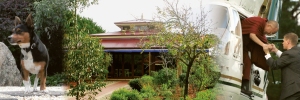Drol Kar Buddhist Centre is a centre of calm in a lush area of Paraparap, close to Angelsea. Drol Kar means White Tara, the goddess of motherly compassion. Whether you are a believer or not in this particular spiritual tradition, places of retreat and devotion often gather an energy that can be felt and enjoyed by visitors. People from various backgrounds have been coming to this location for nearly a decade.
Dhondup’s welcome:
Anyone who visits Drol Kar will probably be greeted by Dhondup, the resident terrier whose genuine excitement, minus any bark, is most inviting. Once a rescue dog, Dhondup (‘good fortune’) now displays a great sense of inner security and joy, and this is perhaps symbolic of much of the great work this centre initiates.
Background:
Drol Kar was established in 2005, when the centre was moved from Geelong to this gorgeous part of Paraparap by Venerable Geshe Sonam Thargye, the centre’s spiritual director and founder. Geshe Sonam Thargye is from the Mahayana line of Tibetan Buddhism and he first came under the direct guidance of the Dalai Lama when seeking refuge in Dharamsala in India. This connection to the Dalai Lama has continued throughout Geshe’s life and work in Australia. Geshe Sonam invited the Dalai Lama to Geelong on two occasions (2002 & 2007). On the second visit in 2007, the Dalai Lama first came to Drol Kar on his way to Geelong.
The centre is managed by a dedicated committee and its resident teacher is Venerable Jampa Drolma. The calendar hosts a range of programs and there is also a shop full of excellent resources. Geshe Sonam’s Nying-Jey international projects have meant bringing health and educational opportunities to communities in India and Tibet. The local and global vision of this spiritual leader becomes clearer the longer you spend time at Drol Kar.
The Grounds and Temple:
This is an oasis for quiet reflection. Sometimes these places can actually be hard to be in, as we must be still in ourselves. The gardens have enough pockets to safely fold one’s self into in order to experience the moment, sit, walk quietly and/or engage with the environment. There are local people who come here regularly to reflect, study, volunteer and be part of a community of shared intentions. The gompa (temple) has been the vessel for many people’s prayers and inner thoughts. Spending time in this space, as any spiritual place, perhaps allows the recipient to enter the prayers and hopes of others who leave their footprints here. When in the temple, nature’s sounds are all around and the border of inner and outer seems to drop away.
Meditation:
There’s a saying that the less time you think you have for meditation, the longer you should do it for. ‘Mindfulness’ is a buzz word at the moment and can mean different practices to different people. Helen McKenzie, a committee member who has been at the centre from its start, provided an excellent definition that goes beyond any differences in techniques. Helen explains mindfulness as ‘being in control of your mind, rather than your mind in control of you’ and the road to getting there as ‘understanding the mind.’ Some mindfulness techniques include visual imagery, following the breath, and other mind and body awareness practices. Ideally we can do these things in a range of situations, but being in this place perhaps gives us more permission, reminders and guidance of how to do so meaningfully.
The Dalai Lama’s Visit:
In 2007 the Dalai Lama visited and unveiled the plaque in the stupa (pagoda) and blessed the gompa (temple). As the great leader’s schedule was tight, he was actually helicoptered in from Melbourne. Landing on the neighbour’s adjoining property, he was greeted through a gate by overjoyed community members and walked along a prepared path into the temple where he shared some teachings. An hour or so later he was then helicoptered off to Geelong for a much larger appearance that many locals still remember.
Your visit:
Drol Kar Buddhist Centre is available for all members of the public so it is certainly worth taking a look at their yearly program or calling the centre for further information about types of visits. While perhaps the whole of the Otways is a temple where each of us can find awe, this is a place on the way there that captures and symbolises some of the things us humans might be doing when we identify with things bigger than ourselves.
Further information: www.drolkarbuddhistcentre.org.au
Phone: 03 52661788


